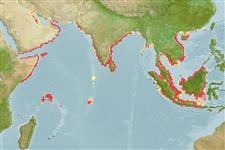Common names from other countries
Environment: milieu / climate zone / depth range / distribution range
Ekologi
; payau; kisaran kedalaman 0 - 20 m (Ref. 348). Tropical; 31°N - 9°S, 44°E - 118°E
Indo-Pacific: from northwest Indian Ocean and the Aden Gulf to Indonesia.
Length at first maturity / Size / Weight / umur
Maturity: Lm ? range ? - ? cm Max length : 6.5 cm SHL jantan/; (Ref. 348); common length : 5.0 cm SHL jantan/; (Ref. 348); Umur maksimum dilaporkan: 3.00 Tahun (Ref. 8702)
Depth range is based on ecology (Ref. 348); to be replaced wtith a better reference. Primarily marine but also invades backwaters and estuaries (Ref. 105059). Found in protected coastal areas, with shallow subtidal waters (Ref. 348). In muddy and sandy substrates (Ref. 105057) where it burrows (Ref. 105059). Family is known to be suspension feeders, filtering planktonic algae and organic matter from the water (Ref. 348).
Life cycle and mating behavior
Kematangan | Reproduksi, perkembang biakan | Pemijahan | telur-telur | Fecundity | Larva
Members of the class Bivalvia are mostly gonochoric, some are protandric hermaphrodites. Life cycle: Embryos develop into free-swimming trocophore larvae, succeeded by the bivalve veliger, resembling a miniature clam.
rujukan utama
Acuan | Koordinator | mitra
Poutiers, J.M. 1998. (Ref. 348)
Status IUCN Red List (Ref. 130435)
status CITES (Ref. 108899)
Not Evaluated
Not Evaluated
ancaman kepada manusia
Harmless
penggunaan manusia
| FishSource |
Alat, peralatan
informasi lanjut
Umur / SaizPertumbuhanpanjang-beratpanjang-panjangMorfologiLarvaKelimpahan
Sumber internet
Estimates based on models
Preferred temperature
(Ref.
115969): 26.6 - 29.3, mean 28.6 (based on 942 cells).
keancaman
Low vulnerability (10 of 100).
